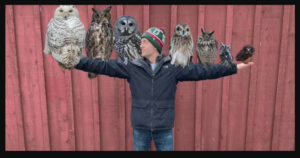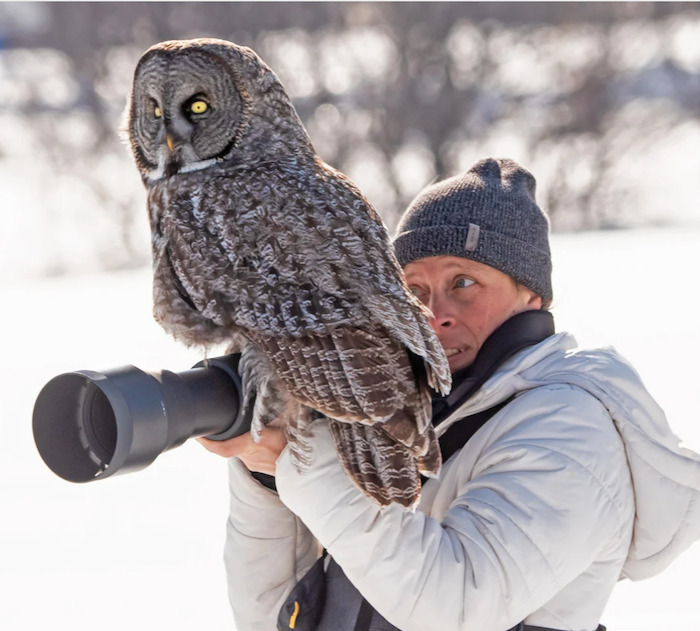November 2017 4:30 p.m. Bundled up against the cold, I’m out exploring the old-growth forest behind our house. Dusk is coming on. I enjoy the soft, cushioned silence, but suddenly, my Spidey sense makes me look up. Impossibly balanced at the top of a very tall, spindly tree is the biggest owl I’ve ever seen, silhouetted against the darkening sky. I freeze in my tracks. It’s gorgeous! So cool! I wonder how the thin branch it’s perched on is supporting its weight.
The only owl I know on sight is the great horned owl—we had lots of those in the California—easily recognizable by its distinctive ear tufts, but this owl’s head was smooth and round. What kind of owl was it?
Thus began my fascination with owls and other raptors in my new home here on the central Oregon coast. On my walks in the forest and along the ocean path, I encountered a pair of bald eagles, barred owls, ospreys, and yes, the familiar great horned owl. I ordered field guides from Amazon, bought a pair of bird-watching binoculars, wore out Audobon’s bird identification site. It turns out the huge owl I saw was probably a migrating great grey or even a snowy owl, which occasionally show up here in winter. Not our usual denizens here, the more common barred owls.
Being on the lookout for these creatures resulted in some magical moments. Once, sitting on my back deck, relaxing, looking out at the forest after sunset, but before full darkness had descended, a large, dark owl silently swooped in from my right, straight through the trees, not five feet above the ground, miraculously avoiding hitting any branches along the way. Magical! Probably hunting.
Another time, I was walking my dog, Finn, across a small bridge in the forest when Finn stopped and stared intently up at something. I followed his gaze and there was a barred owl, not ten feet away, staring straight at us from his perch on a branch of an alder tree, close to the trunk. Just sat there, not worried about us being there at all. Later that week, in the same area, I saw one parent and two fluffy, baby owls perched side by side. Again, they were untroubled by our presence.
So, it’s no surprise that raptors, especially owls, would eventually work their way into one of my novels. They found a home with In Plain Sight: A Logan McKenna Mystery Book 8.
To write the story, I needed to learn a lot more about raptors than my two-minute, greenhorn encounters with them provided. I needed to talk to some experts and observe a variety of raptors up close and personal. After a google search, I discovered the perfect place.
The Cascades Raptor Center in Eugene, OR! As I explored their website, my writer wheels started turning. I realized the center also made for a great setting for a murder. It is a small community of its own, with a director, trainers, a vet, and a groundskeeper, all with interlinking connections, pasts, and secrets of their own.
As I contemplated the structure of the story, I had to get my main character, Logan, out to the center, which was 2 hours away. I decided she would become as fascinated by the local wildlife on the coast as I was, so would volunteer at the Cascades Raptor Center a couple of times a week. Perfect!
I also needed her to stay out there for a few days in a row, not just pop in and pop out for her volunteer hours—she has to be around long enough to solve the crime—so I have one of her new friends in Depoe Bay, Jean Pullman, ask Logan to babysit a rental she’s remodeling near the college. Conveniently to my story line, Jean just happens to be the Lincoln County Medical Examiner. J Always good to have an ME nearby when a dead body shows up.
For me, the research always leads to the story, not the other way around. As I learn more about whatever topic I decide that book is going to feature, characters and plot lines come to me. I make notes as I go, then later decide how to use them.
I most appreciate the bits of dialogue I pick up from people who work in whatever field I’m researching. Where do they hang out? How did they come to do what they do? What are their daily routines? Any of these details can lead to a more authentic and interesting story for my readers.
In my research at the Cascades Raptor Center, Louise Shimmel, the director at that time and the founder of the center, was very helpful. She took me under her wing and answered numerous questions and emails, even after she retired.
During this process, I learned that in real life, while the need for wildlife rescue centers increases, they are chronically underfunded, so if you have even a small amount to contribute to the cause, check out their website. You can even adopt a raptor or schedule a tour. https://cascadesraptorcenter.org/
Here is a cool image for owl size comparisons. The great grey owl above is truly huge up close! The wildlife photographer wasn’t expecting it’s visit, but said the great grey stayed about 10 seconds, then flew away. Obviously not afraid of humans.


 A self-admitted book addict, Valerie was the kid with the flashlight under her pillow. A life of travel with exposure to many different cultures led to a pervasive interest in people, with degrees & teaching credentials in Cultural Anthropology & English.
A self-admitted book addict, Valerie was the kid with the flashlight under her pillow. A life of travel with exposure to many different cultures led to a pervasive interest in people, with degrees & teaching credentials in Cultural Anthropology & English.